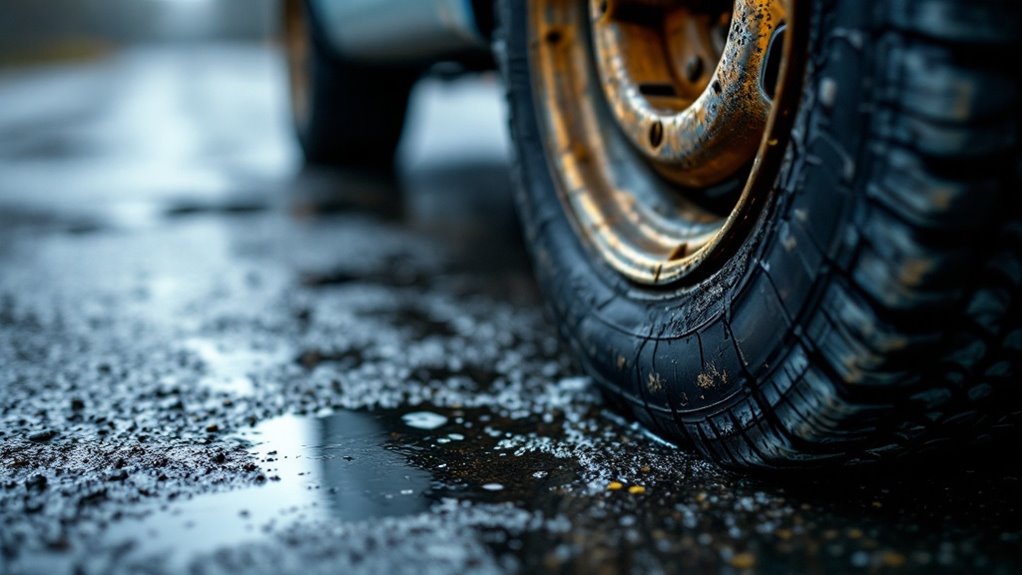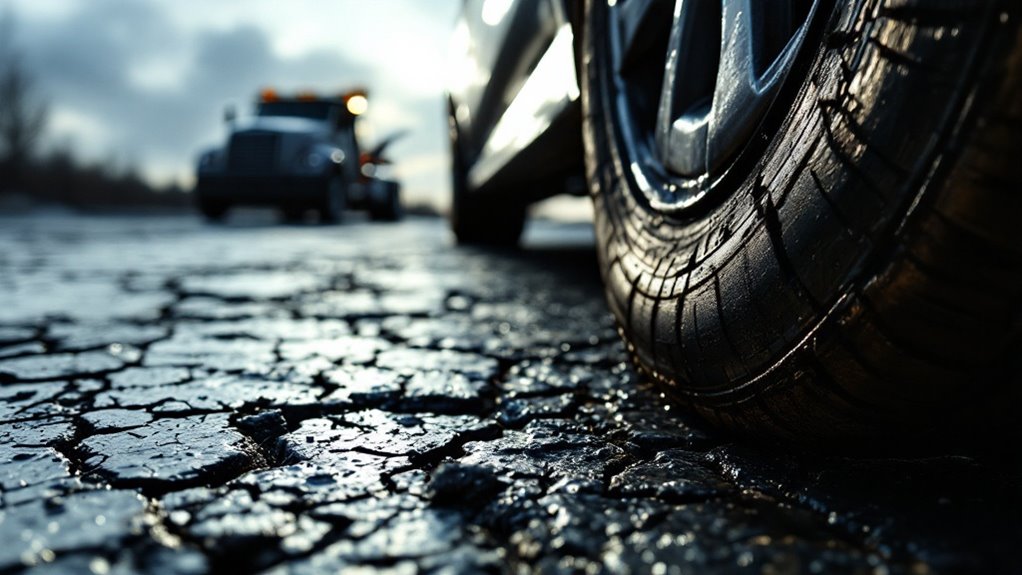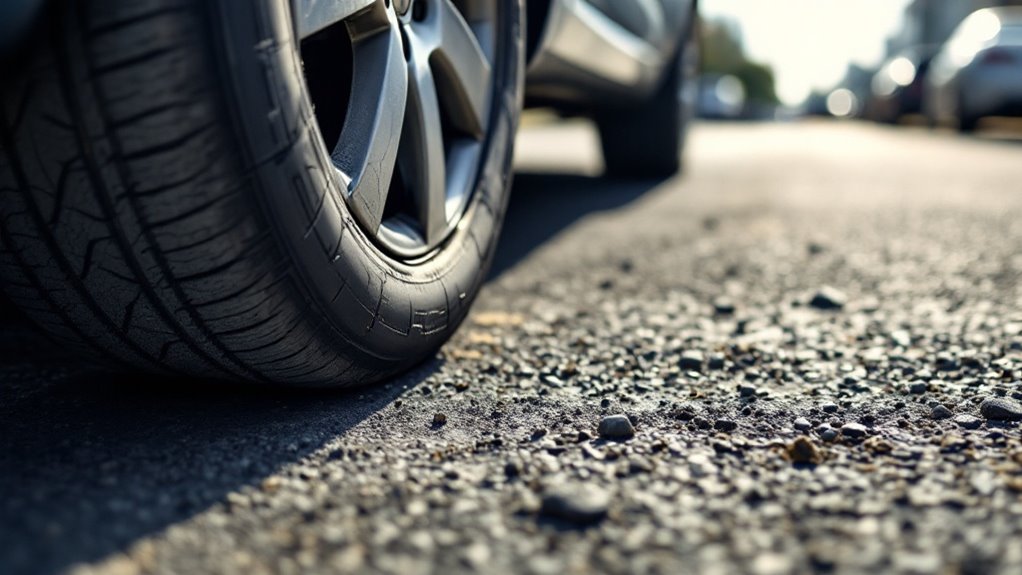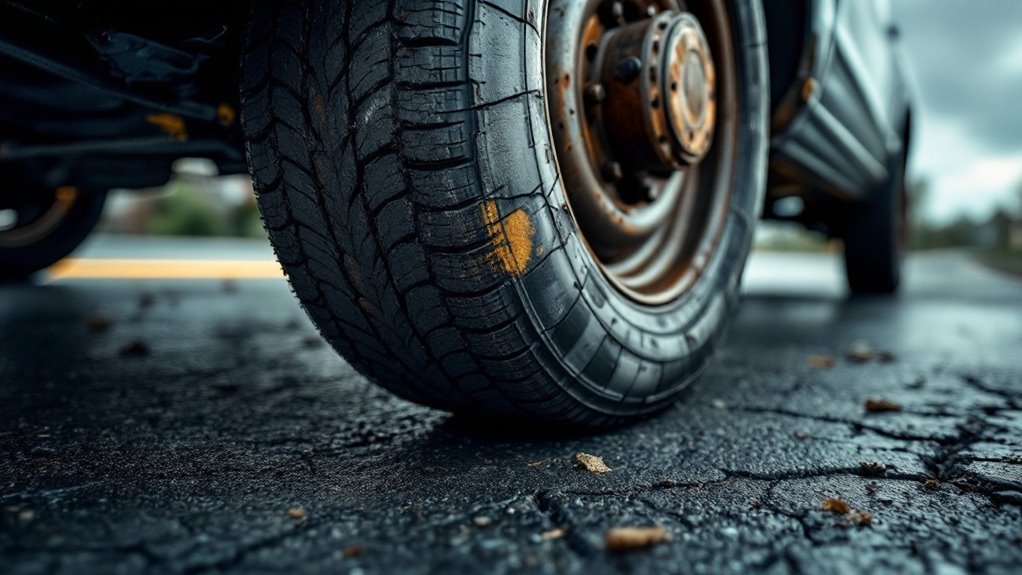Are Bald Tires Illegal
This post contains affiliate links. As an Amazon Associate, we earn from qualifying purchases.
Driving on bald tires is often illegal due to strict tread depth laws that must be met for safety reasons, such as the federal minimum of 2/32 inches for cars or California’s 4/32-inch rule for steering axles. Violating these standards can result in fines ranging from $100 to $500. Below is a quick reference:
- Federal Limit: 2/32 inches
- California Steering Axle: 4/32 inches
Stay tuned for essential maintenance tips and associated risks in the following sections.
Essential Facts in 30 Seconds
- Bald tires are illegal if tread depth is below federal or state limits, such as 2/32 inches for regular cars.
- In California, steering axles require a minimum tread depth of 4/32 inches, while other tires need at least 2/32 inches.
- Fines for driving with bald tires can range from $100 to $500.
- Violating tread depth laws may result in legal fees and penalties.
- Insurance claims may be denied for accidents caused by illegal bald tires.
Legal Standards for Tire Tread Depth
Tires keep your car safe. Know the legal rules for tread depth. Breaking these rules can bring fines. It also risks your safety on the road.
Rules change based on vehicle and place. For regular cars, the federal limit is 2/32 inches. Big trucks need 4/32 inches on steering tires. Some states, like California, set tougher limits. They demand 4/32 inches for steering axles and 2/32 elsewhere. Maintaining proper tire pressure is also crucial for safety and performance.
Check tread depth with a good gauge. Don’t just look at it. Measure the shallowest spot in big grooves. Inspectors check these spots during stops or after crashes. Regular checks ensure compliance with legal limits.
Here’s a fast guide for minimums:
- Regular cars: 2/32 inches
- Big truck steering tires: 4/32 inches
- Motorcycles: 2/32 inches
Measure your tires often. Always follow the strictest rule in your area. Stay safe and avoid trouble.
Safety Hazards of Worn Tires

Let’s talk about why tire tread is so important for safety. Worn tires lose grip, especially on wet roads. Shallow grooves mean more risk of hydroplaning. That’s when water makes tires slip off the road. You can’t control the car then.
At 80 km/h, worn tires at 1.6 mm tread stop 10 meters later. That’s a big danger gap on wet roads. Regular tire rotation can help prevent this by ensuring even tread wear.
Worn tread also makes tires weak and easy to burst. A blowout can cause sudden crashes. You lose control fast, and it’s scary. Check tires often to spot problems early. Bad tires can’t handle road bumps or pressure shifts. Adequate tread depth prevents hydroplaning by channeling water away effectively.
Think about these dangers:
- Hydroplaning: Big risk below 2/32 inch tread.
- Blowouts: Common with low air pressure.
Replace tires on time to stay safe while driving.
Financial and Legal Risks of Bald Tires

Bald tires bring big money and law troubles for drivers. They cost you extra cash fast. Fuel use goes up with bad tires—think 5-10% more gas wasted.
Repairs after tire blowouts can hit $200 to $1,000. Insurance mightn’t pay if bald tires cause a crash. Failed vehicle checks also mean fees. Bald tires increase rolling resistance, leading to decreased fuel efficiency. Additionally, worn tires pose a higher risk of hydroplaning on wet roads, making accidents more likely during adverse weather.
Law problems are just as bad. Fines for low tread depth range from $100 to $500. Accidents with bald tires make you more at fault. Cops might tow your car too.
Legal fees and damages add up quick. Don’t wait—fix tire wear now. Look at these numbers:
- Fines: $100-$500 based on your area.
- Repairs: $200-$1,000 for tire damage.
- Fuel Loss: 5-10% less efficiency.
Tire Maintenance and Prevention Tips

Bald tires create big safety and legal problems. Stay safe by taking care of your tires.
Check tire pressure every month with a good gauge. Match the numbers to your car manual’s advice. Test pressure on cold tires for the best results.
Rotate tires every 5,000 to 7,500 miles. This helps them wear out evenly. Front tires often lose tread faster on edges.
Monitor tread depth with a gauge or penny trick. Replace tires if tread is 2/32 inch or less. Good tread keeps your car gripping the road.
Spot uneven wear, cracks, or bulges early. Check tread wear bars for replacement signs. Switch to winter tires for cold seasons.
Inspect tires after long drives for damage. Always keep a spare tire ready.
Regular checks of tire pressure can significantly improve fuel economy by ensuring optimal performance.
Stay safe and drive longer with these tips!
Consequences of Ignoring Tire Wear

Tires matter a lot for safe driving. Ignore tire wear, and face big trouble. Think about legal, safety, and money problems.
Skip tread checks, and risk fines. Some states charge up to $500. Your car might fail roadworthy tests too.
Safety gets worse with bald tires. Rain makes hydroplaning a real danger. Stopping takes longer on worn tires. Control slips, and accidents can happen. Fatal crashes become a scary risk.
Money issues hit hard as well. Tire neglect leads to crash repairs. Costs can reach thousands in damages. Insurance mightn’t cover your claim. Premiums often jump after accidents.
Legal risks grow with bad tires. Poor handling means you’re at fault. Accidents bring lawsuits and big penalties. Fuel efficiency drops, costing more gas.
Act fast to dodge these dangers. Check tires now and stay safe. At 4/32 tread depth, replacement is strongly recommended to avoid safety hazards.
Frequently Asked Questions
How Can I Measure Tire Tread Depth Myself?
Got tires to check? Grab a penny or a tread depth gauge. Stick it into the tire grooves. See the depth right away. Low tread means danger—replace them fast! Most tires need at least 2/32 inches of tread. Less than that? Time for new ones. Stay safe on the road! Check monthly for best results. Easy, right?
Are There Exceptions for Bald Tires in Emergencies?
Imagine a dark, stormy night. Your car breaks down with a flat tire. Stay calm! Some places, like California, allow bald tires in emergencies. Always prioritize tire safety during such drives. Check your local laws for clear rules. Data shows many states have emergency exceptions. Keep tires in good shape, even for urgent trips. Stay safe on the road!
Do Bald Tire Laws Apply to Spare Tires?
Spare tires must follow the same rules as regular tires. Check the tread depth on your spare. It needs to be safe and legal. Avoid fines by keeping it in good condition. Got a worn spare? Replace it fast! Laws don’t make exceptions for spares. Stay safe on the road today!
Can I Drive With Bald Tires Off-Road?
Got bald tires and thinking about off-road driving? Think twice! Bald tires mean no grip. You’ll slide on rough ground. Safety takes a big hit. Studies show 80% of off-road crashes link to bad tires. Don’t risk it. Get new tires before hitting tough trails. Stay safe out there!
Are Bald Tires Illegal on Private Property?
Got bald tires on your property? Let’s dive into the rules. Private land often allows worn tires. Still, safety matters a lot. Bald tires can cause accidents. Even on your own land, risks exist. Always check local laws first. Stay safe with good tires. Replace them if they’re too worn. Protect yourself and others now.
Conclusion
Bald tires are a big risk. Don’t ignore them. You might want to save cash. But skipping replacement can lead to trouble. Fines or crashes cost way more. Check your tire tread often. Use a penny to test depth. Replace tires before they hit 2/32 inches. This keeps you safe on roads. It also follows the law. Safety matters most every time. Protect yourself and others. Stay smart with tire care. Peace comes with every safe trip.
